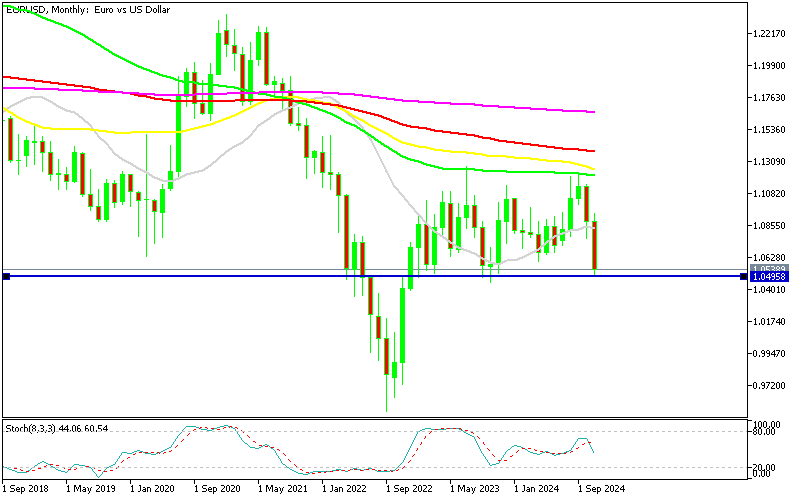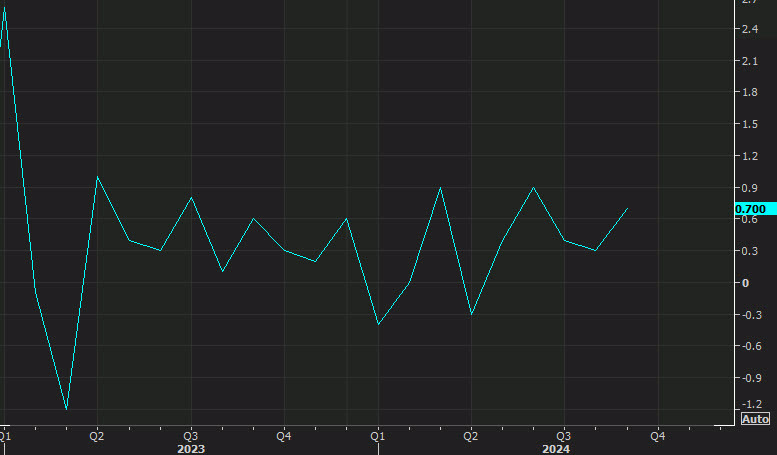EURUSD has made a major reversal in October and the monthly chart is looking very bearish, pointing to 1-1, as the ECB keeps the dovish rhetoric on we
EURUSD has made a major reversal in October and the monthly chart is looking very bearish, pointing to 1-1, as the ECB keeps the dovish rhetoric on weak Eurozone economy, while the FED is looking less dovish as fundamentals in the US are looking strong.

The Euro has fallen to its lowest level since October 2023, despite gaining 6 cents earlier in the year. Momentum shifted, and the currency pair is now trading below 1.05. Back in September, repeated failures to hold above 1.12 signaled that buyers couldn’t sustain those gains, leading to a roughly 7-cent decline.
Over the last two months, the U.S. dollar has regained strength, supported by the Federal Reserve’s more cautious approach to rate cuts and recent developments such as a Republican victory in the U.S. elections and a spike in October’s U.S. CPI inflation. This has helped EUR/USD EUR/USD sellers push the price to the bottom of the 2-year range, with a double-top above 1.12. So, if the bottom of the range at 1.0440s breaks, the double top pattern points to 0.9650.
EUR/USD Chart Monthly – Heading to the Bottom of the Range
US retail sales data for October presented mixed signals. While headline figures surpassed expectations, key components like the control group and ex-autos underperformed. Upward revisions to prior months provided some offset, leading to stronger year-over-year growth (+2.8%). However, the weakness in core categories signals slowing consumer momentum, particularly when adjusted for inflation. This could dampen GDP contributions in Q4 unless spending strengthens in coming months.
US October Retail Sales Report from the Census Bureau![Retail sales control group]()
-
Headline Retail Sales:
- Actual: +0.4%
- Expected: +0.3%
- Prior: +0.1% (revised up to +0.8%)
-
Control Group (Key GDP Input):
- Actual: -0.1%
- Expected: +0.3%
- Prior: +0.7% (revised up to +1.2%)
-
Retail Sales Total Value:
- October: $718.9 billion
- September: $714.4 billion
-
Retail Sales Year-over-Year (YoY):
- October: +2.8%
- September: +1.7%
-
Sales Excluding Autos:
- Actual: +0.1%
- Expected: +0.3%
- Prior: +0.5% (revised up to +1.0%)
-
Retail Sales Excluding Autos and Gas:
- October: +0.1%
- September: +0.7%
The latest data presents a more positive picture when factoring in significant upward revisions to previous figures, underscoring the resilience of U.S. consumers throughout the year. Even with rising borrowing costs, consumer spending remains robust as the holiday season draws near. Control group data, a key metric for GDP calculations, points to steady consumer demand in Q4. Additionally, growth in food service spending highlights continued activity in this particularly sensitive category, indicating that consumers are still prioritizing discretionary expenditures despite economic pressures.
Meanwhile, the Eurozone economy continues to struggle, with policymakers maintaining a dovish stance and reiterating plans for rate cuts. Germany’s economic weakness adds to these challenges, as the region’s largest economy is forecast to shrink by 0.1% in 2024 before modestly growing by 0.7% in 2025. Despite these pressures, the European Central Bank (ECB) has held off on cutting interest rates, citing slow labor productivity and robust wage growth as key factors in their decision.
Comments from the ECB policymaker
- The pace and extent of rate reductions will depend on incoming data.
- Current developments align with a consumption-driven recovery.
- It remains uncertain whether the recovery will solidify.
- The ECB should avoid being more restrictive than necessary to bring inflation to target in a timely manner.
- Tolerating an economy running persistently below potential to guard against future inflationary shocks could be counterproductive.
EUR/USD Live Chart
EUR/USD
www.fxleaders.com


